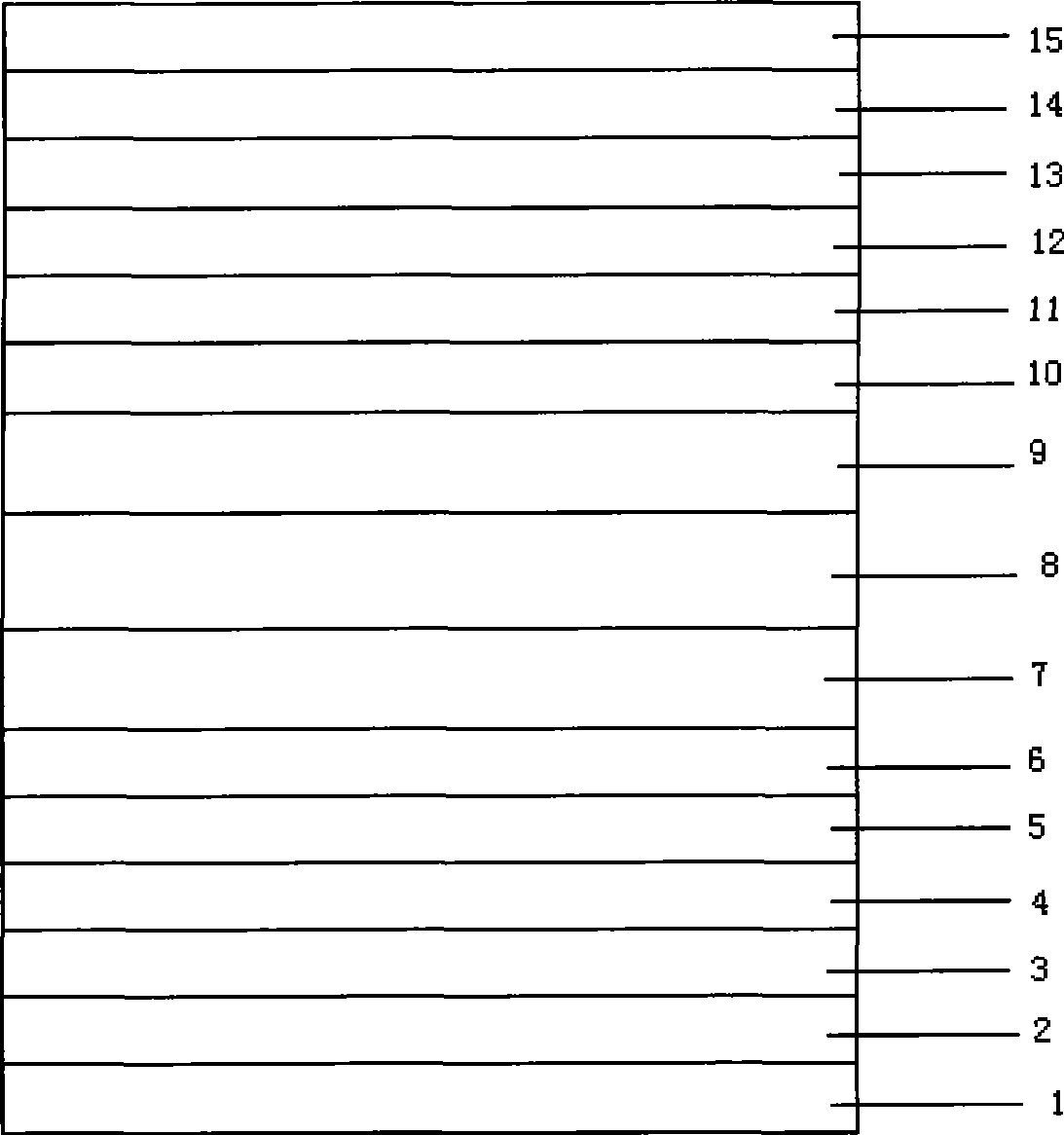Three-junction solar cell
A solar cell, three-junction technology, applied in the field of solar cells, can solve the problems of unavailability of part of the current of the top cell and the bottom cell, poor current matching of the three sub-cells, and difficulty in the photoelectric conversion efficiency of the battery, so as to improve the photoelectric conversion efficiency, The effect of improving conversion efficiency and increasing current
- Summary
- Abstract
- Description
- Claims
- Application Information
AI Technical Summary
Problems solved by technology
Method used
Image
Examples
Embodiment 1
[0025] A solar cell, characterized in that the cell structure is as follows: from bottom to top, it includes a back electrode layer 1, a bottom cell layer, a transition layer, a lower tunnel junction layer, an intermediate cell layer, an upper tunnel junction layer, a top cell layer, and an anti-reflection layer. Film layer 14 and upper electrode layer 15, wherein:
[0026] The bottom cell layer consists of a p-type Ge single crystal substrate 2 and an n-type Ge epitaxial layer 3 from bottom to top;
[0027] The transition layer is an n-type GaAs layer a4;
[0028] The lower tunnel junction layer consists of a heavily doped n-type GaAs layer a5 and a heavily doped p-type GaAs layer a6 from bottom to top;
[0029] The middle battery layer is composed of a p-type GaAs layer 7 and an n-type GaAs layer b9 and a quantum well structure 8 sandwiched between the p-type GaAs layer 7 and the n-type GaAs layer b9 from bottom to top, and the quantum well structure 8 is divided into The ...
Embodiment 2
[0035] A solar cell, characterized in that the cell structure is as follows: from bottom to top, it includes a back electrode layer 1, a bottom cell layer, a transition layer, a lower tunnel junction layer, an intermediate cell layer, an upper tunnel junction layer, a top cell layer, and an anti-reflection layer. Film layer 14 and upper electrode layer 15, wherein:
[0036] The bottom cell layer consists of a p-type Ge single crystal substrate 2 and an n-type Ge epitaxial layer 3 from bottom to top;
[0037] The transition layer is an n-type GaAs layer a4;
[0038] The lower tunnel junction layer consists of a heavily doped n-type GaAs layer a5 and a heavily doped p-type GaAs layer a6 from bottom to top;
[0039] The middle battery layer is composed of a p-type GaAs layer 7 and an n-type GaAs layer b9 and a quantum well structure 8 sandwiched between the p-type GaAs layer 7 and the n-type GaAs layer b9 from bottom to top, and the quantum well structure 8 is divided into The ...
Embodiment 3
[0045] A solar cell, characterized in that the cell structure is as follows: from bottom to top, it includes a back electrode layer 1, a bottom cell layer, a transition layer, a lower tunnel junction layer, an intermediate cell layer, an upper tunnel junction layer, a top cell layer, and an anti-reflection layer. Film layer 14 and upper electrode layer 15, wherein:
[0046] The bottom cell layer consists of a p-type Ge single crystal substrate 2 and an n-type Ge epitaxial layer 3 from bottom to top;
[0047] The transition layer is an n-type GaAs layer a4;
[0048] The lower tunnel junction layer consists of a heavily doped n-type GaAs layer a5 and a heavily doped p-type GaAs layer a6 from bottom to top;
[0049] The middle battery layer is composed of a p-type GaAs layer 7 and an n-type GaAs layer b9 and a quantum well structure 8 sandwiched between the p-type GaAs layer 7 and the n-type GaAs layer b9 from bottom to top, and the quantum well structure 8 is divided into A qu...
PUM
 Login to View More
Login to View More Abstract
Description
Claims
Application Information
 Login to View More
Login to View More - Generate Ideas
- Intellectual Property
- Life Sciences
- Materials
- Tech Scout
- Unparalleled Data Quality
- Higher Quality Content
- 60% Fewer Hallucinations
Browse by: Latest US Patents, China's latest patents, Technical Efficacy Thesaurus, Application Domain, Technology Topic, Popular Technical Reports.
© 2025 PatSnap. All rights reserved.Legal|Privacy policy|Modern Slavery Act Transparency Statement|Sitemap|About US| Contact US: help@patsnap.com

